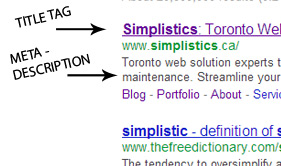On-site SEO | on-site vs. off-site optimization
April 17, 2013
If you compare company prices, you might wonder why online marketing companies charge vastly different amounts for Search Engine Optimization services. My client recently asked me this question, so we discussed the different between on-site and off-site SEO. Please check back in a few days for my post detailing the importance of off-site SEO.
To assure your website has a great ranking on search engines like Google, it is important you utilize the following on-site SEO tools:
Title Tag: This is arguably the most important tag for on-site SEO. Search Engines like Google use this descriptive tag to learn about your website. As well, your title tag will be the text that appears as the title in search results.
If you run a local deli in Toronto called Corner Deli, your title tag should read “Corner Deli | Toronto’s gourmet subs”. Note: It is best to make the title tag relevant to every individual page on your website.
Meta description: The meta description not only gives search engine further details about your website, but this tag will also display under your title tag in search results.
Your Corner Deli description tag should read “Providing healthier food choices while keeping our meal options tasting great”. Note: It is best to make the description tag relevant to every individual page on your website.
Website Authority: Your website visitors do not want to read – they want you to provide them with just the information they need. Your website content should be to the point, only giving your website visitors the most relevant information. If you have too much text on your web pages that does not provide unique quality content, your overall website authority will go down and so will your website ranking.
Content Keywords: Fill your website content with keywords that are relevant to your website. Find specific words that have low competition and a high search volume, and build your website text around it. When successfully executed, your website should appear within the search rankings when a user searches for your targeted keyword.
You can use the amazing Google Keyword Tool by clicking here to find the perfect keywords for your website.
H tags: Just like this blog post, my title “The importance of on-site Search Engine Optimization | On-site vs. Off-site SEO” is wrapped in an h1 tag, telling search engines that this is an important heading on my page. A subheading could be wrapped in an h2 tag, and a sub-subheading can be wrapped in an h3 tag. H tags work in a hierarchical structure that define the importance of headings on your webpage.
Alt Attribute: Every image on your website should have an alt attribute. This attribute provides additional information about your image to search engines.
If you have an image of Corner Deli’s sub, the alt attribute should contain the text “turkey sub with ketchup and onions”.
